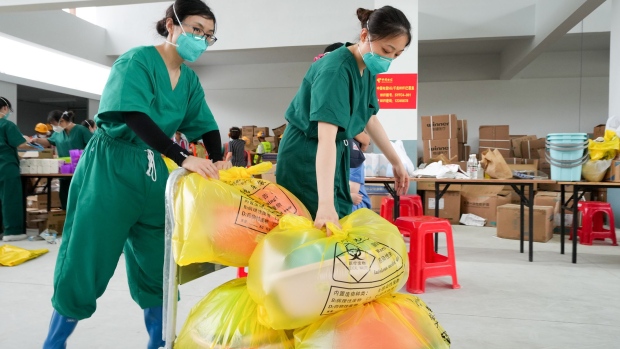Aug 17, 2022
China’s Covid Cases Surge to Three-Month High on Hainan Outbreak
, Bloomberg News

(Bloomberg) -- China’s Covid cases surged to a three-month high, driven by a worsening outbreak in the tropical Hainan province that has become the country’s biggest since Shanghai was shut down in the spring.
The rising number of infections also caused alarm elsewhere, with hundreds of vehicles stuck on a state highway in Tibet after a neighboring province refused to allow more travelers from the hard-hit region to enter. Authorities in the coastal city of Xiamen, meanwhile, began testing fishermen and their daily catches for the virus for fear that it may be spreading through illegal trade.
There were 3,424 infections reported across China for Wednesday, up from 2,888 a day earlier. Of the total, 2,018 were in Hainan province, up from 1,663, as transmission continues despite a two week lockdown of most of the island. Tibet added 228 local cases as of Thursday afternoon.
The outbreak in Hainan, dubbed China’s Hawaii, is concentrated in the resort city Sanya, which reported 1,231 cases for Wednesday. It has built four field hospitals as of Aug. 16, providing more than 7,000 beds. More than two thousand medical workers from Shanghai, Shandong, Guangxi and other provinces have been dispatched to Hainan to assist with the effort.
China’s Covid czar and a vice premier, Sun Chunlan, arrived in Hainan on Aug. 13 to provide direction for the control efforts, as she has with other hotspots across the country. She said the province needed to step up its treatment and quarantine facilities, and cut community transmission.
The trip underscores the seriousness of the outbreak in the region, and concern from Beijing about Hainan’s ability to handle the virus. It is in a particularly perilous situation, trying to simultaneously contain the virus locally and ensure it isn’t carried home with departing visitors.
Stranded Tourists in China Resort Island See Hope After Protests
Sun also asked authorities to help the 150,000 tourists stranded on the island, some of whom have begun to protest after being locked down for more than 10 days. The airport in Sanya resumed operation on Monday, though there was some disruption. There were long wait times and availability was unstable, with some flights canceled, according to tourists who were still trying to leave Sanya.
Miles of Traffic
A decision by officials in Yunnan province to deny entry to travelers from Tibet over the weekend because of a lack of quarantine facilities created a four-mile traffic jam involving hundreds of cars, despite police urging residents to avoid the routes that had backed up. The turmoil highlights concern that people returning from popular vacation destinations and other areas where flareups are occurring could bring the virus with them, incubating future outbreaks.
Fear that trading with foreign fishermen could open the door to infection led authorities in Xiamen to mandate daily tests for the workers and their “goods,” leading to mocking on some social media sites as videos emerged of fish getting oral swabs. While researchers in China say the virus can survive on some foods, regulators elsewhere have said there is no credible evidence of risk. Officials in the Jimei district of Xiamen couldn’t be reached for comment.
(Updates with details on Tibet and fish testing in the second paragraph and the last two paragraphs)
©2022 Bloomberg L.P.


